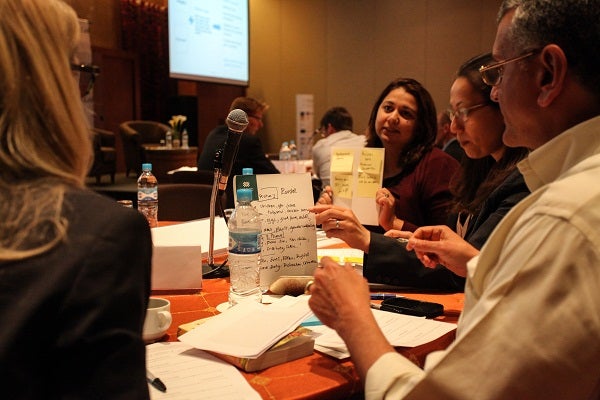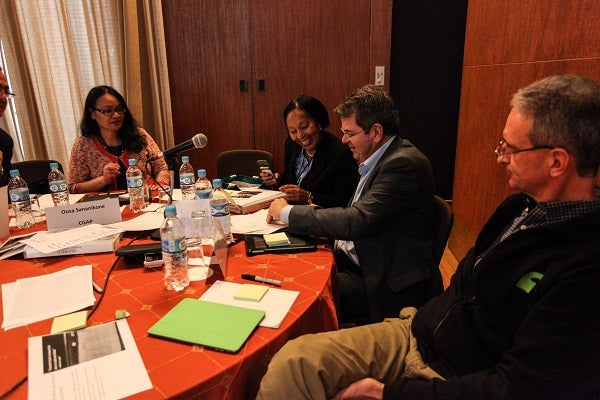Lessons from the 2014 CGAP Annual Meeting in Peru
Every year, CGAP’s Council of Governors (CG) brings together more than 30 international organizations committed to global financial inclusion. At the core of the meeting is reflecting on trends and priorities in the field as well as determining the role that CGAP should play in advancing responsible, market-based innovations to advance for poor people access to the financial services they need to improve their lives.
This year’s CG Meeting took place in Urubamba, a small community in the outskirts of Cusco, in Peru. A market traditionally better known for its burgeoning microfinance environment, Peru seems to be in for a serious transformation. Many of the things happening today illustrate the kinds of issues at the center of CGAP’s global solutions development agenda.

Five things we learned from Peru during our CG Meeting:
- Linking Government Conditional Cash Transfer (CCT) programs with Graduation-out-of-Extreme-Poverty approaches works. From 2009 to 2012, the Juntos Financial Inclusion program conducted a series of pilots that showed how this linkage can empower women in extreme poverty, but economic inclusion can only happen if other policy interventions bring basic infrastructure and public services. Peru’s national social inclusion policy is built on these fundamental learnings.
- Agent banking can significantly expand the boundaries of both banks and MFIs. Examples like Banco BCP and Caja Sullana demonstrate how agent banking in Peru has multiplied by 15 – 25 times the size of their branch networks and can reach many poor and low density areas that were previously beyond reach. This has brought an interesting convergence of MFIs and banks competing for lower-income segments.
- A competitive environment for digital payments is high on the policymaker agenda. Recent regulatory reforms in Peru have created a framework for non-bank institutions to issue electronic money. This is a significant bet. With more than two thirds of its population living in rural areas, a disruptive change like this is driving new solutions in the market.
- Bank-led consortiums can pool efforts to compete in the mobile payments space. The ASBANC consortium is the national bank association tasked with deploying a shared mobile solution targeting the low-income and poor. It aims to pool banks’ efforts to achieve economies of scale needed to reach the rural and poor while also opening up the possibility for banks to compete with targeted offerings in urban areas like Lima.
- Deep government commitment to financial inclusion makes a difference. In 2011 Peru joined the Maya Declaration, committing to adopt financial inclusion goals as part of its national development policy. On Feb 15th, 2014, President Humala signed the Supreme Decree 029-2014 to create Peru’s Multi-sectoral Commission for Financial Inclusion, aimed at ensuring financial inclusion remains a consistent priority across policy interventions across different sectors.

A series of senior government officials who spoke at the CGAP Annual Meeting about Peru’s priorities in financial inclusion underlined the Government’s commitment. Paola Bustamante, Minister of Development and Social Inclusion (MIDIS) reflected on the role of the state in reaching out to the poorest, figuring out viable solutions to sustainably serve the poor through efforts led by Banco de la Nación and the Programa Juntos. Oscar Graham Yamahuchi, Director General for Financial Markets at the Ministry of Finance and Economics and President of the Multisectorial Commission for Financial Inclusion, spoke about the commitment the government as a whole is making to integrating financial inclusion goals across development policy. Daniel Schydlowsky, Head of the SBS spoke about the need to lead market development by fostering innovation, driving competition and facilitating knowledge in the private sector about opportunities in the market.
The Annual Meeting finished with firsthand visits of field operations at the frontier of market development. The learnings from Peru, the government’s commitment, and the many new solutions and ongoing development efforts powerfully confirmed CGAP’s global priorities to advance financial inclusion.
The presentation at the CG meeting by CGAP CEO Tilman Ehrbeck is available here:

Add new comment